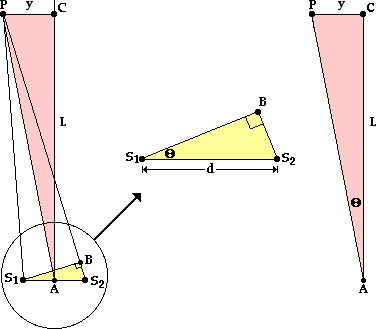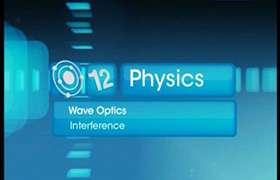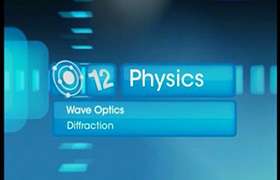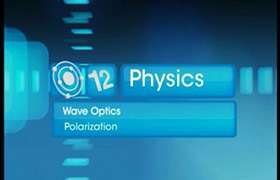CBSE Class 12-science Answered
The diagram below on the left depicts two sources labeled S1 and S2 and separated by some distance d. Point P is a point on the screen that happens to be located on some nodal or antinodal line; as such, there is an order value (m) associated with this point. Point C is the central point on the screen. The distance from point P to point C as measured perpendicular to the central antinodal line will be referred to as y. The screen is located a distance of L from the sources. In the following derivation, the wavelength of light will be related to the quantities d, m, y and L.

On the diagram above, source S2 is further from point P than source S1 is. The extra distance traveled by waves from S2 can be determined if a line is drawn from S1 perpendicular to the line segment S2P. This line is drawn in the diagram on the left above; it intersects line segment S2P at point B. If point P (a bright spot on the screen) is located a great distance from the sources, then it follows that the line segment S1P is the same distance as BP. As such, the line segment S2B is simply the path difference. That is, the small distance S2B is equal to the difference in distance traveled by the two waves from their individual sources to point P on the screen. The logic is as follows:
|
|
Assertion | Logic/Rationale |
| i | S2P = S2B + BP | See diagram above left |
| ii | If screen is very far away (L >>> y), then lines S1P and BP are || | |
| iii | S1P = BP | If S1P and BP are || and line S1B is perpendicular to BP, then the length BP = length S1P |
| iv | S2P = S2B + S1P | Since S1P = BP, the expression S1P can be substituted into i |
| v | S2B = S2P - S1P | Algebraic manipulation of iv; subtract S1P from each side |
| vi | S2B is the PD | The path difference (PD) is defined as | S2P - S1P | |
The yellow triangle in the diagram on the left above is enlarged and redrawn in the middle of the graphic. The triangle is a right triangle with an angle theta and a hypotenuse of d. Using the sine function, it can be stated that
sine(But since it has been previously stated that the path difference (PD) is equal to the length of the line segment S2B, the above equation can be rewritten as
sine(It can be further asserted that the pink triangle (![]() S1BS2) and the yellow triangle (
S1BS2) and the yellow triangle (![]() ACP) in the diagrams above are similar triangles. To prove that any two triangles are similar, one must show that they have two corresponding angles that are equal. Since the line segment PC was drawn perpendicular to the central antinodal line, it forms a 90-degree angle with the line AC. Thus, the corresponding angles S1BS2 and ACP are equal.
ACP) in the diagrams above are similar triangles. To prove that any two triangles are similar, one must show that they have two corresponding angles that are equal. Since the line segment PC was drawn perpendicular to the central antinodal line, it forms a 90-degree angle with the line AC. Thus, the corresponding angles S1BS2 and ACP are equal.
The second set of corresponding angles of equal measure is ![]() S1S2B and
S1S2B and ![]() APC. This can be proven by returning to the assumption that the screen is very far away (L >>> y). Clearly, the lines S1S2 and PC are parallel lines. As such, the diagonal line S2P creates two alternating angles that are equal in measure - that is,
APC. This can be proven by returning to the assumption that the screen is very far away (L >>> y). Clearly, the lines S1S2 and PC are parallel lines. As such, the diagonal line S2P creates two alternating angles that are equal in measure - that is, ![]() S2PC =
S2PC = ![]() S1S2B. Since it is assumed that L >>> y, the line segment S2P and AP are roughly parallel to each other and thus make roughly the same angle with the line segment S1S2. With this assumption, it is thus proven that
S1S2B. Since it is assumed that L >>> y, the line segment S2P and AP are roughly parallel to each other and thus make roughly the same angle with the line segment S1S2. With this assumption, it is thus proven that ![]() APC =
APC = ![]() S2PC. Since the
S2PC. Since the ![]() S2PC is equal to both
S2PC is equal to both ![]() S1S2B and
S1S2B and ![]() APC, it follows that
APC, it follows that ![]() S1S2B =
S1S2B = ![]() APC. As such, the pink triangle (
APC. As such, the pink triangle (![]() S1BS2) and the yellow triangle (
S1BS2) and the yellow triangle (![]() ACP) have two corresponding angles that are equal and thus are similar triangles.
ACP) have two corresponding angles that are equal and thus are similar triangles.
If the pink triangle (![]() S1BS2) and the yellow triangle (
S1BS2) and the yellow triangle (![]() ACP) are similar, all corresponding angles are equal in measure, and so
ACP) are similar, all corresponding angles are equal in measure, and so ![]() S2S1B =
S2S1B = ![]() PAC. These two angles are labeled as theta in the diagrams above. The use of trigonometric functions allows one to relate the angle theta to the reliably measured distances d, y and L.
PAC. These two angles are labeled as theta in the diagrams above. The use of trigonometric functions allows one to relate the angle theta to the reliably measured distances d, y and L.
| sine |
|
tangent |
The above logic has consistently assumed that the screen upon which the interference pattern is projected is very far away; that is, L >>> y. This is typically the case for visible light interference patterns. In fact, the L value is typically on the order of several meters while the y value is on the order of a couple of centimeters. For such dimensions, the angle theta is less than 1 degree. For such small angles, the approximation that the sine ![]() = tangent
= tangent ![]() can be made. Taking 1 degree as a sample angle, calculated values of the sine and tangent can be compared.
can be made. Taking 1 degree as a sample angle, calculated values of the sine and tangent can be compared.
| sine (1 deg) = 0.017452406 |
|
tangent (1 deg) = 0.017455064 |
Note that the values for the sine and the tangent of 1 degree show agreement out to the fourth significant digit. Since the sine and the tangent of these small angles are approximately equal, we can state that their ratio of lengths (as stated above) is also equal. That is,
PD / d = y / LIn the previous section of Lesson 3, it was shown that the path difference (PD) for any point on the pattern is equal to m ![]() , where m is the order number of that point and
, where m is the order number of that point and ![]() is the wavelength. By substitution,
is the wavelength. By substitution,
As a final step in the derivation, the equation can be algebraically manipulated so that the wavelength (![]() ) is by itself:
) is by itself:









